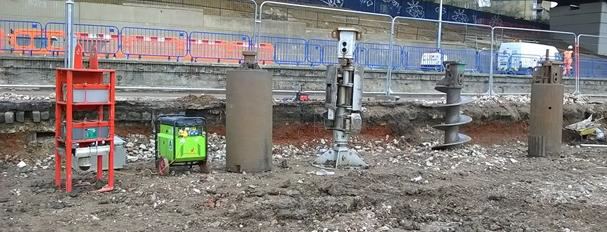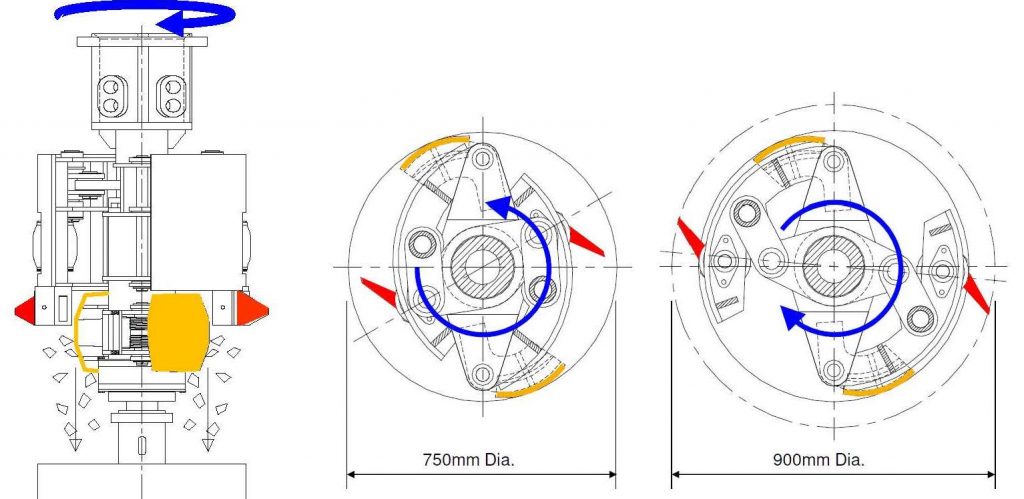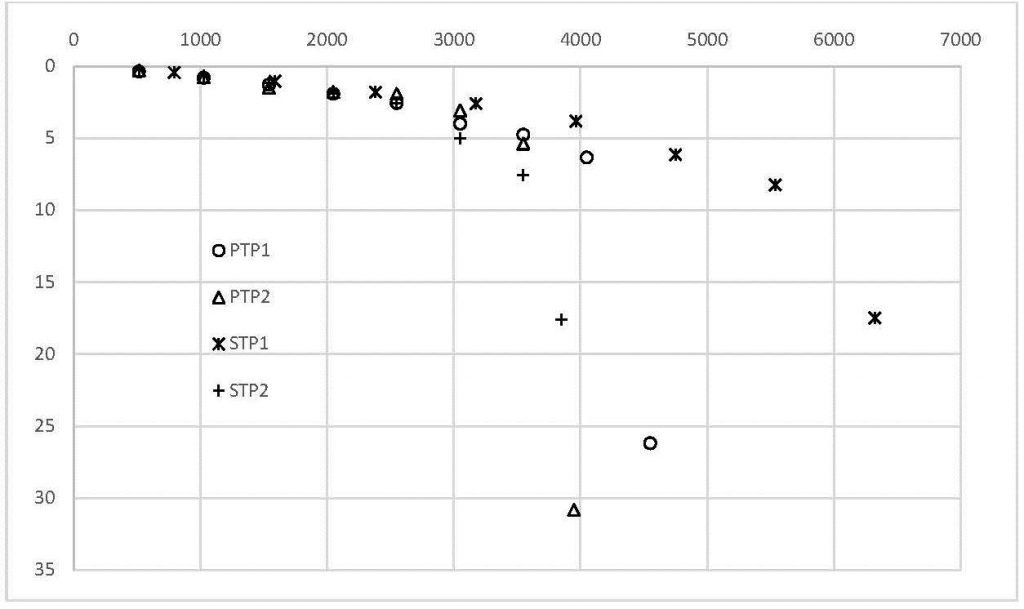
Enhanced Capacity of Threaded Rotary Bored Piles at Paddington New Yard
Document
type: Technical Paper
Author:
David Hard
Publication
Date: 10/11/2015
-
Abstract
The materials used in constructing piles form a significant part of the cost of the construction and have high environmental impact through a large amount of embedded carbon. The largest part of this is the concrete, which typically forms around a third of the cost. It is not normally the case however that pile sections work to their structural maximum as the pile design is controlled by the amount of load that can be transferred into the ground.
This paper will address a new technique that has been developed to improve the pile efficiency through the modification of existing rotary bored pile techniques. This is achieved by the creation of a thread around the main straight shaft of the pile, enhancing the interface with the ground. This mechanism allows a greater load to be carried than the equivalent full concreted section whilst reducing the amount of materials involved in the pile construction. Remote access inspection techniques, based upon those used in the inspection of under ream piles, are used to demonstrate the effectiveness of the threading process, combined with static load tests to validate the design assumptions.
The successful implementation of the pile method on the Crossrail site at Paddington New Yard has allowed the verification of the technique as a practical alternative to traditional rotary bored piles. The use of static load tests has been used to verify the design parameters and predicted 40% enhancement in shaft friction produced through the creation of the threads.
-
Read the full document
Introduction
The use of open bore rotary bore piles has long been a viable solution for deep foundations in stable ground conditions such as London Clay. The load that can be carried on such piles however is limited not by the structural capacity of the section, but rather by the geotechnical capacity. These piles are at their most efficient when relatively long and slim and working predominantly in shaft friction.
The shaft friction is a function of the adhesion between the pile and the clay and is controlled by the condition of the interface. There are several factors that effect this, including but not limited to, the relaxation of the bore with time, the possible softening due to seepages and ratio of length to depth.
The use of a thread on the pile helps counter act these and improve the interaction between the pile and the surrounding clay. This is due to the interface being improved mechanically by the thread which causes the two to be interlocked. The result of this is that the failure plane is pushed out to be in undisturbed ground away from the initial bored shaft and so the possible softening and relaxation effects are reduced. The effective geotechnical diameter of the pile is also increased through this process.
The potential of using threads on the shaft of such piles, as a method of increasing capacity, had been recognised by the industry but it had proven difficult to implement such a technique. This has in part been possibly due a reluctance from Clients to deviate from tried and tested methods, and in part by a belief within the industry that the process of creating the threads added complication to a construction process that relies on efficiency to return profit.
As part of an in house R&D programme, Bachy Soletanche Ltd (BSL) spent time developing a tool and process that would allow them to produce a threaded rotary bored pile. This was taken to sites and pile tests carried out to determine the degree of enhancement that could be expected. At the end of this process a patented threaded pile type, called SolThread for marketing purposes, had been brought to the point of being ready for industrial implementation.
Implementation at Paddington New Yard
The proposed piling for the new structures at Paddington New Yard offered a potential location to use the SolThread technique at full industrial scale on a live contract.
The ground conditions were suitable, with a short depth of superficial materials overlying the London Clay, and the Engineer’s choice on diameters already meant that traditional open bore rotary piles were the preferred solution.
Just as importantly however was the contractual arrangement that allowed the Main Contractor to put forward alternatives to the Client, Crossrail, through the use of an OCI period. This reflected the approach of an open minded Client who was keen to investigate value engineering options, plus support the use of innovative methods to the benefit of the project.During the tender period BSL had identified to the Main Contractor, Costain, the potential for savings through the use of threaded piles. Upon award of the contract this option was further investigated and the decision made to present it to Crossrail for their consideration.
This entailed technical presentations to both the Crossrail site team and their technical team in order to explain the benefits being put forward, and to give them the confidence in the new system.
The proposal for preliminary static load tests to be carried out, combined with the historical information from previous tests carried out by BSL, allowed sufficient confidence for the scheme to be taken to construction. Final approval of the scheme was dependant on the results of the pile tests.
Benefits to the project
The use of threaded piles meant that less concrete was required to carry the same load, compared to the conforming scheme. This of course then also meant a reduced volume of spoil to be removed from site.
Both of these reductions in volumes lead to a reduction in the amount of truck movements that would be needed on the site. This had potential benefits both to the project and to the surrounding community.
The site is long and narrow in shape with the access route running from end to end. This arrangement created a long potential interface between site workers and traffic. A solution that reduced the risk on this through less traffic had safety benefits for site operatives in addition to any environmental improvements.
A similar benefit was to be gained for the local community. The site entrance was immediately adjacent to both a bus station and a tube station as well as busy roads. This combination meant a significant number of potentially vulnerable pedestrians would be interacting with the site traffic. The reduction in the number of trucks that needed to traffic through this area would therefore reduce the potential risk to these individuals, plus through reduced emissions aid in improving local air quality. As the concrete plant used for the project was local this also produced an indirect improvement to local air quality through the use of less concrete meaning that there is less CO2 produced by the plant.
It was these benefits that encouraged Crossrail to proceed with the SolThread alternative, in addition to the technical and commercial benefits.
Construction methodology
The aim of the development of SolThread was to increase the efficiency of the pile section so as to minimise the amount of concrete required, or to increase the load carried for the same pile size. At the same time, in order for the new technique to gain acceptance it needs to have similar or better levels of productivity when compared to existing traditional methods.
The process is based upon the normal construction technique for an open bore rotary bored pile, where a conventional 750mm diameter pile is constructed using a Kelly bar and auger to excavate the pile to the required depth. The SolThread tool is then placed inside the open bore and lowered to the bottom of the pile shaft. Once the pile threading process is ready to commence, the teeth are mechanically extended outwards to give a thread cutting diameter of 900mm diameter and the thread forming process is initiated. The thread forming procedure inside the pile shaft wall is performed by rotating the tool and at the same time extracting the tool from the pile bore at a given rate to produce a pre-defined thread pitch.
The design incorporates a so called crumb bucket beneath the cutting tool to catch the spoil produced by the thread formation, and hence reduce the amount of cleaning required at the end of the pile threading. This bucket minimises the amount of times tools are required to be placed within the shaft after thread formation and so minimises the chance of any damage to the thread prior to concreting of the pile.
Remote access inspection techniques, based upon those for inspection of under ream piles, are used to allow a visual inspection of the completed bore prior to moving to the next stage of cage installation. This forms an important part of the quality control process as it gives the opportunity to demonstrate the effectiveness of the threading process. At Paddington New Yard, the first five works piles were checked after threading using this technique to give confidence to the Crossrail site team. Based on the results that were seen this it was deemed acceptable to relax this and the rate was dropped to one in every twelve piles.
A secondary and immediate check on the effectiveness of the threading process can be made during construction when the tool is withdrawn to empty the crumb bucket. If the contents at this point do not match the amount of pile that has been threaded then it is an instant indicator of a potential problem.
The process of creating the threaded pile is protected under patent by Soletanche Bachy, and the product is marketed in the UK under the name “SolThread”.
Fig 1: CCTV unit, portable generator, Crumb Bucket, Threading Tool on Stand, Traditional Auger and Cleaning Bucket.
Fig 2: Threading Tool – Opening and Closing of Tool.
Design verification
A critical part of getting the alternative foundation solution accepted was the proposal to carry out
sacrificial pile tests to verify the design assumptions. Due to the site geometry it was proposed to
carry out tests in two locations at either end of the site. At each set up both SolThread and traditional
piles would be installed and load tested.The graphs below compare the performance of the straight shafted rotary piles with that of the
associated threaded piles.PTP1: 750mm diameter, 21.50m deep STP1: 750/900mm diameter, 21.50m deep
PTP2: 750mm diameter, 21.00m deep STP2: 750/900mm diameter, 15.50m deepThe results show that where the threaded pile is the same length as the straight pile (PTP1 vs STP1), there is a significant increase in load carried. The shorter SolThread pile, which was designed to have the same capacity as the longer traditional pile (PTP2 vs STP2) has shown very similar performance but on a significantly shorter pile.
The design of shaft friction of a pile in clay is a function of the undrained shear strength of the clay and the interface between the pile and the ground, represented by an adhesion factor called alpha. The creation of the thread around the pile shaft meant that the traditional values were no longer valid and new ones had to be determined through the testing process. The results from previous testing carried out by Bachy Soletanche meant that the design principles had already been established but needed to be refined for this particular project.
The testing carried out has proved that the shaft adhesion factor can be increased from the usual value of 0.5 up to 0.8 through the use of the thread. This results in an increase in shaft capacity of 40%. The volume of concrete used in the thread is around 10 to 15% above the volume of the core of the pile, depending on the exact diameter used. The current tool used at Paddington New Yard was based on a 750mm diameter central core, threaded out to 900mm diameter. The table below compares the volumes of 1.0 metre depth of pile for standard 750mm diameter pile against a standard 900mm diameter pile and a 750/900mm diameter SolThread pile.
Diameter Volume % increase (volume) % increase (shaft capacity) 750 0.442 0 0 900 0.636 44 20 750/900 SolThread 0.508 15 40 The design of the pile has to make an allowance however, for the proportion of the pile which is threaded, and that which is not, to reflect the fact that the bottom 3 meters over the depth of the crumb bucket cannot be threaded. The upper portion of the pile above the top of the clay which is supported by a temporary casing is also not threaded, although this may not be load bearing depending on the ground conditions. Due to the bottom of the pile not being threaded, the base capacity is calculated on the basis of the smaller core diameter and not the larger threaded diameter.
On the Paddington project the increased capacity of the SolThread pile resulted in the piles being shortened from 21.0m for standard 750mm diameter piles to 15.5m for the 750/900mm SolThread, a saving of 27% on length, and 15% on volume.
An assessment of the carbon savings using the EFFC “Carbon Calculator” indicates that this corresponds to a reduction of 10% for the SolThread pile compared to an equivalent straight shafted pile.
Lessons Learnt
The first lesson, and probably the most important, to be learnt from the project is that the use of an OCI period allowed the time for alternatives to be fully investigated by the Contractor and then presented and discussed with the Client.
This meant that the benefits and reasoning could be thoroughly examined without time pressures cutting the process short before the full potential could be established.
This process still required both the Client and their Engineer to be open to the proposal for a new technique to be used on the project. It also required the site representatives from these organisations to be educated in how the new technique varied from the processes they were more familiar with.
The enhancement in skin friction of threaded piles over straight shafted have been verified through the use of pile tests. These tests also allowed the use of lower design factors in the pile design with additional savings resulting on pile length.
The initial construction process had a significant amount of check points to verify the threading had been carried out successfully, most notably through the use of the CCTV to allow Crossrail site staff to satisfy themselves as to the end result. Initial dialogue had identified however a willingness to allow this to be relaxed to a regime of occasional spot checks if the site team could be convinced of the consistency and quality of the process. A process for managing expectations on both sides ensured that the necessary requirement to prove the process and quality did not result in an unwieldy system of checks that would negate the benefits of the reduced volumes through the increase in time spent on construction.
Conclusions
The degree of enhancement in alpha value has been demonstrated through tests. As the degree of enhancement taken in the design is significant it was important that the piles performed in line with predictions for the credibility of the alternative. Further testing in other over consolidated clays, such as Oxford Clay, will supply more data on how much this effect varies with clay type and plasticity.
It is clear however that following this successful implementation there is now scope for this technique to be used on other projects. This will be both in the current diameter and also potentially in other larger ones as well.
The savings in materials used and subsequent sustainability benefits are real and of a level that allows Clients to consider the environmental benefits to their project as well as the commercial ones. This covers not just the material coming into site but also the spoil to be removed, with the associated knock on benefits that this produces.
The ability to carry the same load on shorter pile through the use of the threading means that there will be sites where the toe level of the piles will no longer penetrate into strata requiring the use of support fluid. This is a situation commonly seen in the London area where the penetration of piles into the potentially water bearing Lambeth Group beneath the London Clay can have a significant impact on the pile construction technique. If the piles can be kept up in the “dry” strata then the whole process will be quicker and the environmental impact of having to dispose of spoil classified as “contaminated” is removed.
The construction process is neutral in terms of time as the increased time on the threading process is offset against time saved on the initial shorter pile bore. This is important as confirms that there is no negative impact on the programme.
-
Authors


